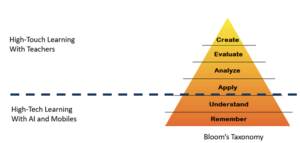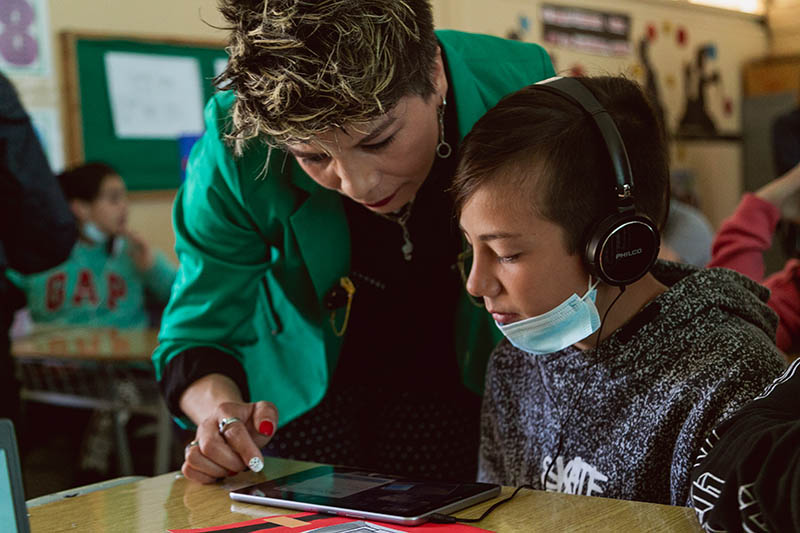“Data cannot suffer. They have no inner self, they have not survived anything, they have never had the audacity to go beyond their limitations”. This is what Australian musician Nick Cave said a few weeks ago, when someone used artificial intelligence to create a song “in his style”. And we will never tire of repeating it. Today, and hopefully for a long time to come, the success of any technology depends on the quality and depth with which it is shaped by the human experience.
Let us take another clear example. Could a bad film director, with all the technological means at his disposal, make a film capable of moving an audience and transcending time? The answer is ‘No’. Technology undoubtedly helps. And with this help, inspired people can create amazing things: films, songs, enterprises or – and this is where we begin to focus the aim of our article – educational experiences.
High-Tech High-Touch and its application to education
The more technology and data-driven organisations become, the more their success depends on the people involved. This is true for any type of organisation, including educational organisations.
With the progressive implementation of technology in the classroom and the development of intelligent tutoring platforms and systems, we need approaches that allow us to properly integrate both concepts. High-Tech High-Touch is emerging as one of the most suitable. But what is this approach and how does it apply to education? Let’s take a look.
The term was coined by John Naisbitt, an American sociologist and expert on new technologies. He introduced it in 1991 in his book High Tech High Touch: Technology and Our Search for Meaning and it quickly became one of the most popular terms used to describe the relationship between technology and humanity.
High-Tech High-Touch is a term used to describe the combination of advanced technology (High-Tech) with a human and personalised experience (High-Touch). It refers to the idea that as technology advances and becomes more pervasive in our lives, it is also important to maintain a human connection and a personalised experience for a more effective and satisfying interaction.
The idea behind it is that technology and automation should not replace human and personalised interaction, but should complement it in order to achieve a more complete and satisfying experience for users or customers.
As we have said, ‘smart’ technologies, now omnipresent, are revolutionising education: reshaping processes, underpinning new educational models and opening up new possibilities, enabling us to address some of the most persistent educational challenges, such as learning poverty and education divides. Education and technology are beginning to be seen as a difficult pairing to separate.
We know that technology is a force for innovation that moves fast over short distances. We saw this with the COVID-19 crisis, when the face-to-face education of millions of students was abruptly interrupted and school systems had to show a nimble capacity for adaptation and innovation that surprised us all. So the major changes that were expected to take years to materialise happened in months, but now we must turn that impromptu momentum into a systemic and systematic digital transformation that can make the most of these technologies to provide quality learning for all children.
In this context, the “High-Tech, High-Touch” approach is one of the best options for extending the enormous possibilities of personalised learning to the most disadvantaged students. How? Let’s see.
With the expansion of new adaptive learning platforms, a cost-effective way of learning at the right pace and level for students in resource-constrained contexts is being offered.
Until now, the insurmountable workload of meeting the demands of individual learners with very different backgrounds and abilities had hindered and discouraged even the most enthusiastic teachers from implementing the personalisation of learning in their classrooms. However, with the expansion of new adaptive learning platforms, a cost-effective way of learning at the right pace and level for students in resource-constrained contexts is being offered. And this is where the “High-Tech, High-Touch” approach comes in.
The availability of these platforms could radically reduce the burden on teachers to provide core content to large numbers of diverse students (‘High-Tech’) and free up time for teachers to focus on ‘high-touch’ learning through projects, discussions, hands-on experiences and the fostering of higher-order skills such as complex problem-solving and social-emotional skills (‘High-Touch’) (Steer, 2019).
Applying this approach to Bloom’s taxonomy, as we can see in the image, students start by remembering and understanding content, interacting with AI and mobile technology (High-Tech), and then learn to apply, analyse and evaluate what they have understood and, finally, learn to create new content, interacting with teachers (High-Touch) (Steer, 2019).

Source: Steer, 2019 (adapted from Johnson, Dale P. Adoptive + Active model: A new Approach to General Education, Arizona State University, 2018.
In this way, HTHT delegates to technology the more systematic work of content presentation and exercise and offers the teacher the opportunity to support the individual path of each student. For their part, students have the opportunity to approach the content at their individual level of appropriation and work at their own pace without having to adapt to a single speed that may not be their own.
HTHT delegates to technology the more systematic work of content presentation and exercise and offers the teacher the opportunity to support the individual path of each student.
Hi-Tech-High-Touch en entornos vulnerables
Como los enfoques High-Tech High-Touch (HTHT) se dirigen a las necesidades individuales de los alumnos, ha demostrado ser especialmente beneficioso para los estudiantes más rezagados. De hecho, ya ha mostrado resultados prometedores en Vietnam, Corea del Sur y Uruguay.
Así, en Vietnam, The Education Commission desarrolló, en colaboración con el Ministerio de Educación y Formación de Vietnam y la Universidad Estatal de Arizona, un prototipo HTHT para aprender Matemáticas en séptimo grado que, además, exploraba el papel de los profesores en un contexto de aprendizaje adaptativo. Tras un solo semestre, generó resultados significativos: según una evaluación externa, los resultados de los alumnos en los exámenes de matemáticas mejoraron el equivalente a dos años de aprendizaje. Además, los profesores se familiarizaron con la tecnología didáctica y colaboraron en torno a los datos de los alumnos, optimizando su capacidad de influir en su aprendizaje y aumentar su satisfacción.
También se están llevando a cabo pruebas en otros contextos con resultados prometedores: en Uruguay, el Plan Ceibal está poniendo en práctica un programa piloto de HTHT para Matemáticas y Pensamiento Computacional en más de 100 escuelas de Uruguay. En Corea del Sur, el hub asiático de la Education Commission ha creado un consorcio nacional de HTHT con 27 universidades, ocho empresas de tecnología educativa, seis ciudades, cuatro escuelas, dos fundaciones y un consorcio K-12 que está utilizando HTHT con los alumnos más desatendidos en todo el país.
Un consorcio mundial
Con el objetivo de hacer realidad la visión del aprendizaje personalizado para todos los estudiantes combinando, como hemos dicho, las ventajas únicas del profesor y el poder de la tecnología, The Education Commission ha creado High-Touch High-Tech for All (Alto Contacto, Alta Tecnología para todos), una iniciativa mundial y multisectorial centrado en diseñar, probar y ampliar los enfoques HTHT en todo el mundo, prestando especial atención a los contextos con importantes dificultades de aprendizaje.
El Consorcio facilitará la colaboración entre los múltiples actores que puedan aportar, promoverá y compartirá investigaciones y evidencias de impacto y dirigirá la labor política para abordar las necesidades del ecosistema. Entre sus miembros habrá profesores, líderes escolares, asociaciones escolares, proveedores de tecnología educativa y de redes, organizaciones multilaterales, empresas de investigación, organizaciones sin ánimo de lucro, gobiernos, universidades y líderes mundiales de la juventud. Entre sus acciones principales:
- Análisis: sintetizará evidencias de impacto y buenas prácticas innovadoras que combinen el uso de la tecnología con la transformación de la forma de enseñar de los profesores.
- Cambio: trabajará con los gobiernos para probar y evaluar la viabilidad de los enfoques en diferentes contextos utilizando un enfoque sistémico. Evaluará el ecosistema para la introducción de HTHT a escala, incluido el análisis de las políticas nacionales, las estrategias y el mercado de EdTech, y trabajará con los países para desarrollar vías individualizadas para la ampliación.
- Ampliación y escalamiento: facilitará el aprendizaje y la acción a nivel mundial para impulsar la adopción de enfoques HTHT en todos los contextos e influir en las organizaciones, los donantes y el sector privado para apoyar las pruebas continuas y la ampliación para crear entornos propicios para HTHT. Desarrollará una plataforma mundial para que las partes interesadas compartan conocimientos e ideas, y para que las escuelas y los proveedores de tecnología educativa entren en contacto. Ello también permitirá a los miembros del Consorcio conectarse y colaborar entre sí para idear proyectos relacionados con HTHT. Teniendo en cuenta los problemas de infraestructura de los países de renta baja, será esencial adoptar medidas intermedias para facilitar la digitalización y garantizar su ampliación.
Hibridar es combinar: en el caso de la educación digital, de tecnologías pioneras con las experiencias docentes para hacer más humanas y personalizadas las dinámicas pedagógicas en sus aulas. Centrar, por tanto, los esfuerzos en desarrollos e investigación de plataformas como la que representa HTHT supone apostar por la calidad educativa para todas y todos, en cualquier lugar, en diferentes momentos de aprendizaje. ¿Serán apuestas como esta las que hagan visible la promesa de lo digital como palanca central para la tan deseada transformación educativa?
Referencias
Steer, L. 2019. Combining High-Tech and High-Touch to Personalize Learning for Every Child. The Education Commission.






